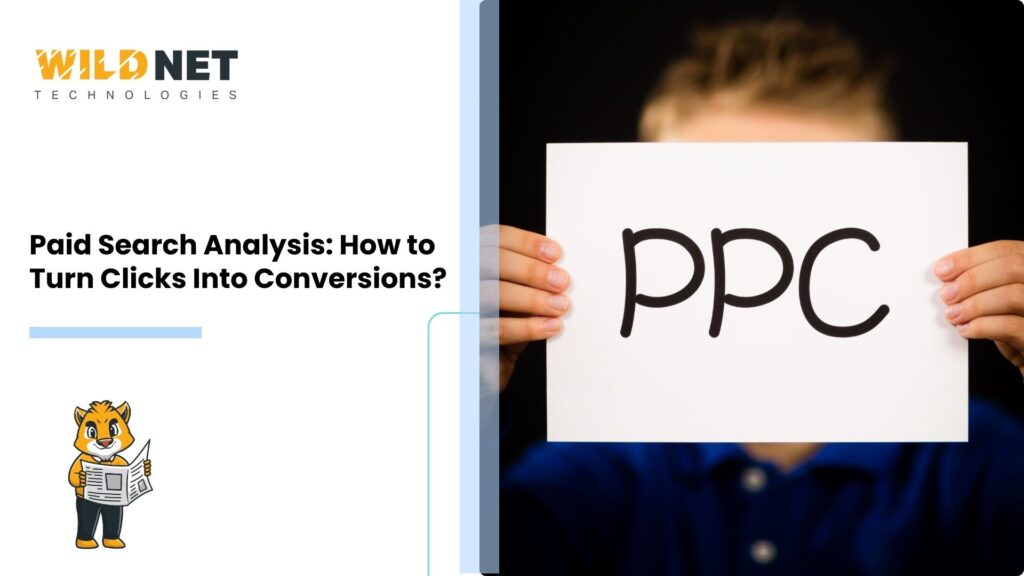In the world of digital marketing, paid search is a key player. It’s a powerful tool that can drive traffic, boost visibility, and increase conversions.
But to truly harness its potential, you need to understand the data. That’s where paid search analysis comes in.
Paid search analysis is the process of examining your paid search campaigns. It involves tracking metrics, studying trends, and interpreting data. The goal? To optimize your campaigns and maximize your return on investment.
This is crucial in today’s competitive digital landscape. With businesses vying for the exact keywords and audiences, every click counts. And turning those clicks into conversions is the ultimate goal.
But how do you do that? How do you turn data into actionable insights? How do you ensure your paid search campaigns are delivering the best possible results?
This guide will answer those questions. It will delve into the intricacies of paid search analysis, from return on investment (ROI) analysis to competitive analysis. It will provide strategies for optimizing your campaigns and turning clicks into conversions.
So, whether you’re a seasoned digital marketer or a business owner looking to boost your online presence, this guide is for you. Let’s dive into the world of paid search analysis and discover how to turn clicks into conversions.
Understanding Paid Search Analysis
Paid search analysis is the backbone of successful digital marketing. It involves diving deep into your campaigns to track performance.
Through this analysis, marketers assess the effectiveness of their strategies. This process involves monitoring key metrics, such as click-through rates (CTR) and cost per acquisition (CPA). The ultimate aim is to identify areas that need improvement.
Practical paid search analysis helps businesses make informed decisions. It enables you to optimize campaigns for improved performance. You can also respond quickly to changing customer behaviors and market dynamics.
Key elements to focus on include:
- Analyzing traffic sources to understand where visitors come from.
- Examining ad performance to refine strategies.
- Studying conversions to measure how well ads are turning traffic into sales.
- Evaluating keyword effectiveness to optimize targeting.
- Monitoring ad spend to ensure budgets are used efficiently.
By focusing on these aspects, businesses can gain valuable insights. These insights can then be used to refine marketing strategies, leading to a higher return on investment (ROI).
Moreover, paid search analysis can reveal trends and patterns. These insights are crucial for staying ahead in a competitive market. Recognizing these trends early can give you a competitive edge.
Implementing a robust paid search analysis framework is essential. It not only boosts campaign effectiveness but also enhances overall marketing success.
The Importance of ROI in Paid Search
Return on Investment (ROI) is a metric that matters most to marketers. It measures the profitability of your paid search efforts.
Understanding the return on investment (ROI) of your campaigns is crucial. It tells you how well your investments are paying off. A high ROI indicates a successful campaign, meaning ads convert efficiently.
Without ROI analysis, you might waste resources on ineffective strategies. By focusing on ROI, you can allocate budgets more wisely, maximizing your marketing dollars.
Moreover, ROI analysis helps you identify high-performing campaigns. These insights enable you to replicate successes in future strategies.
Ultimately, tracking ROI helps keep you aligned with business goals. It ensures that your marketing efforts contribute to overall profitability. This alignment is essential for sustainable business growth.
Setting Clear Campaign Goals and Objectives
Setting precise goals is the foundation of successful paid search. Clear objectives provide direction and focus for your campaigns.
Start by defining what you want to achieve with each campaign. Do you aim to increase website visits, boost sales, or enhance brand awareness?
Having specific goals makes performance measurement easier. You can track progress and make adjustments as necessary. Without concrete objectives, you risk aimless spending and vague results.
Moreover, clear goals improve team collaboration. Everyone works towards common targets, enhancing overall effectiveness.
Setting goals also influences campaign structure. For example, if increasing sales is the aim, focus on keywords with purchasing intent.
Finally, regularly reviewing and revising goals is critical. As market conditions change, your objectives should adapt. This flexibility ensures sustained success in your paid search endeavors.
Conducting Effective Paid Search Analysis
Conducting practical paid search analysis is crucial for understanding the success of a campaign. It involves systematically evaluating different aspects of your advertising efforts.
First, gather all relevant data. Ensure you have access to comprehensive reports and metrics. This data is the foundation of any meaningful analysis.
Next, break down your analysis into manageable parts. Focus on various areas, including performance metrics, budget utilization, and audience engagement.
Always use tools designed for analytics. Tools like Google Analytics or specialized PPC software can provide deeper insights. They make tracking simpler and more effective.
It is essential to maintain consistency in your analysis efforts. Regularly review your data to spot patterns or irregularities. Consistency enables timely adjustments that can enhance outcomes.
Prioritize your findings. Not every metric or result will be equally important. Identify critical areas that directly affect ROI and conversion rates.
Finally, communicate results effectively. Share insights with relevant team members. An informed team is better equipped to implement necessary changes.
Key elements of practical analysis include:
- Regularly scheduled reviews.
- Comprehensive data collection.
- Use of robust analytical tools.
- Prioritization of key insights.
- Effective communication of results.
By focusing on these areas, you ensure your analysis is productive and actionable.
Identifying and Tracking the Right Metrics
Identifying the right metrics is a cornerstone of successful paid search analysis. Not all metrics carry the same weight or relevance.
Start by aligning metrics with your business goals. This alignment ensures that you track what truly matters, such as conversions and click-through rates (CTR).
Metrics that should be prioritized include ROI, CPA, and Quality Score. These directly influence campaign effectiveness and profitability.
Next, categorize metrics into performance, efficiency, and impact. Performance metrics relate to how well ads perform, like CTR. Efficiency metrics involve cost measures such as CPA. Impact metrics relate to overall business contributions, such as ROI.
Tracking these metrics requires robust tools. Leverage analytics software for accurate data collection. This precision ensures your insights are reliable.
Finally, regularly review and refine your metrics. As campaigns evolve, so should the metrics you track. This flexibility keeps your analysis sharp and relevant.
Key metrics to track include:
- ROI for profitability analysis.
- CPA for cost management.
- CTR for performance insights.
- Quality Score for ad relevance.
- Conversion rates for effectiveness assessment.
By focusing on these metrics, you ensure your analysis leads to actionable outcomes.
Keyword Research and Selection
Keyword research is the bedrock of successful paid search campaigns. Choosing the right keywords drives targeted traffic to your ads.
Start by understanding your audience’s language. What terms do they use to search for products or services like yours? This knowledge guides your keyword selection process.
Leverage tools such as Google Keyword Planner. These tools help identify keywords with high search volume and relevance. They also provide insights into keyword competition and cost per click.
Consider long-tail keywords. These terms have lower search volume but often attract more qualified leads. They can be less expensive and more precise for targeting specific areas.
Track keyword performance over time. This tracking helps identify which terms are most effective in generating conversions. It’s crucial for optimizing your strategy.
Remember, keyword research is not a one-time task. It requires constant monitoring and adjustment. As market trends shift, your keywords should too.
Proper keyword selection ensures your ads appear to the right audience, increasing click-through rates and conversions.
Competitive Landscape: Paid Search Competitive Analysis
Understanding the competitive landscape is vital for succeeding in paid search. It involves analyzing what your competitors are doing.
Begin by identifying your main competitors. Know who they are and what campaigns they run. This knowledge forms the basis of any competitive analysis.
Use tools to spy on your competitor’s keywords, ads, and strategies. Software like SEMrush or SpyFu can provide valuable insights into competitor tactics.
Analyze their ad copy and landing pages. Look for gaps or opportunities you can exploit. This analysis can inform your campaign adjustments.
Understand their strengths and weaknesses. Their weaknesses are your opportunities. Their strengths are areas where you need to compete more aggressively.
Keep an eye on market trends that influence their strategies. This awareness allows you to anticipate changes and adapt quickly.
Through paid search competitive analysis, you gain a clearer picture of the market. It guides strategic adjustments for better positioning and performance.
Paid Search Competitor Analysis: Learning from the Competition
Learning from your competition can significantly improve your campaigns. Paid search competitor analysis helps identify effective strategies and areas for growth.
First, examine the keywords your competitors target. Understand why they chose them and how they perform. This insight can influence your keyword strategy.
Next, assess their ad creativity. What messages and visuals resonate with the audience? Understanding this can help refine your ad copy and design.
Study their conversion paths. How are they turning clicks into conversions? This understanding can inform your landing page and funnel strategies.
Consider their bid strategies. Are they aggressively bidding on specific keywords? Analyze how this affects their ad visibility.
Look for gaps in their approach. Are there any untapped areas or audiences they overlook? These gaps represent opportunities for you to capitalize on.
Continual monitoring is key. As competitors adapt, so should your analysis and strategies. This dynamic approach ensures sustained success in paid search efforts.
Optimizing for Conversions
Turning clicks into conversions is the ultimate goal in paid search campaigns. Optimization focuses on improving the entire journey, from ad interaction to conversion.
Start by revisiting your ad relevance. Ensure your ad copy aligns with your target audience’s search intent and interests. Relevance increases the likelihood that clicks will turn into conversions.
Evaluate your landing pages. Are they designed to capture leads? A well-crafted landing page is crucial for persuading visitors to take action.
Examine the user experience on your site. Ease of navigation and fast load times enhance conversion chances. A frustrated visitor is unlikely to convert.
Implement personalized strategies. Tailored messages and offers resonate better with audiences. Leverage customer data for personalized experiences.
Track your conversions meticulously. Utilize tools like Google Analytics to identify where conversions occur and where they are lost.
Finally, adjust your strategies based on data insights. Continuous analysis and iteration are key for optimizing conversions.
Key tactics for optimization include:
- Crafting relevant ad copy.
- Designing persuasive landing pages.
- Enhancing user experience.
- Implementing personalized strategies.
- Tracking conversions effectively.
- Iterating based on insights.
These tactics help maximize the conversion potential of your paid search campaigns.
Ad Copy and Landing Page Optimization
The impact of ad copy on conversions is significant. A compelling message can draw more clicks and direct prospects to your site. Start by addressing your audience’s needs directly in your ad.
Craft a clear and strong call-to-action (CTA). Your audience should understand what you want them to do next, increasing the chances of conversion.
Move to the landing page design. The landing page should seamlessly extend the message of the ad. Consistency ensures that visitors find the content they are promised.
Optimize your landing pages for speed and mobile devices. A sluggish or non-responsive page can deter potential customers from converting.
Align the messaging on your landing page with user expectations. Use concise text and compelling visuals to hold their attention.
Every element on the page should serve the central purpose: converting visitors. Frequent testing helps refine your approach and improve results.
A/B Testing: Refining Your Approach
A/B testing is crucial for refining ad copy and landing pages. It involves testing two versions to see which performs better.
Start by identifying elements to test. These might include headlines, CTAs, images, or even color schemes.
Implement one change at a time to precisely understand its impact. Testing multiple variables can obscure results and make conclusions unclear.
Analyze the results to determine the winning version. Use this data to implement changes across your campaign. A/B testing is an ongoing process; always search for new elements to improve.
Through systematic A/B testing, you gain insights into what appeals most to your audience. These insights help sharpen your paid search strategies for better outcomes.
Conversion Tracking and Attribution
Effective conversion tracking is the backbone of any successful paid search campaign. It allows you to measure the effectiveness of your ads and understand what drives conversions.
Utilize tools such as Google Analytics and conversion tracking pixels. These tools help you monitor user actions and attribute them to your marketing efforts.
Detailed attribution models are necessary. They provide insights into which campaigns contribute the most to conversions. This understanding helps allocate resources effectively.
Examine both direct and indirect conversion paths. Direct paths are immediate conversions from clicks, while indirect paths involve multiple interactions.
Consider multi-touch attribution. This model accounts for various touchpoints in a user’s journey. It provides a comprehensive view of the entire conversion process.
Understanding the nuances of conversion attribution enables you to accurately assess the efficacy of your paid search strategies and make informed optimization decisions.
Advanced Paid Search Analysis Techniques
To enhance your paid search strategy, leverage advanced analysis techniques. These methods provide deeper insights that drive performance improvements.
Begin by harnessing sophisticated analytics tools. These platforms offer detailed reports and metrics to inform your decisions.
Next, consider the benefits of data segmentation. By organizing data into specific groups, you gain a more nuanced understanding of your campaign’s performance.
Leverage AI and machine learning for predictive analytics. These technologies can forecast trends and suggest optimizations based on historical data.
Incorporate multi-channel analysis. Understanding interactions across different platforms can highlight areas for cross-channel optimization.
Embrace visual data representation. Graphs and charts simplify complex data, making trends easier to spot.
Key advanced techniques include:
- Utilizing powerful analytics tools.
- Implementing data segmentation strategies.
- Leveraging AI and machine learning.
- Conducting multi-channel analysis.
- Using visual data representation.
Together, these techniques offer a comprehensive framework for refining your paid search campaigns.
Utilizing Analytics Tools for In-Depth Analysis
Analytics tools are crucial for a thorough paid search analysis. Google Analytics, SEMrush, and others provide detailed insights into campaign performance.
Leverage these tools to monitor key performance indicators. These include click-through rates, conversion rates, and cost per acquisition.
Advanced tools also offer segmentation and comparison features. These allow you to analyze specific data sets and track progress over time.
Custom dashboards enable you to visualize data according to your specific needs. This makes spotting trends and potential issues simpler.
By utilizing analytics tools effectively, you can make informed decisions that enhance the efficiency and effectiveness of your campaign.
Segmenting Data for Granular Insights
Data segmentation provides detailed insights by dividing your data into smaller, focused groups. This technique allows for analysis at a granular level.
Begin by identifying key variables. These might include demographics, geography, or user behavior.
Tailor your segments to align with your campaign objectives. This could involve grouping by product type or user journey stage.
Segmentation helps uncover patterns that broad data sets might conceal. These patterns inform targeted strategy adjustments.
By focusing on specific segments, you gain a deeper understanding of your audience’s preferences and behaviors.
This understanding enables the delivery of more personalized and effective paid search experiences.
The Role of AI and Machine Learning
Artificial intelligence (AI) and machine learning are transforming paid search analysis. These technologies offer predictive insights and streamline decision-making processes.
AI can rapidly analyze vast amounts of data. This speed allows for real-time adjustments, keeping campaigns agile and responsive.
Machine learning models identify patterns and trends. They predict future performance, enabling proactive campaign optimizations.
Moreover, these technologies automate routine tasks. Automation frees up time for strategic planning and creative development.
Incorporating AI into your analysis provides a competitive edge. It ensures your strategies remain aligned with evolving market dynamics.
As AI capabilities expand, expect even more refined tools and enhanced predictive power in your paid search analysis.
Best Practices and Future Trends in Paid Search
For optimal results in paid search, following best practices is essential. These strategies ensure campaigns are effective and adaptable.
Align your paid search efforts with overall business goals. This alignment ensures campaigns support broader objectives and maximize impact.
Regularly review and update your keyword strategy to ensure optimal performance. Search behaviors change, and so must your keywords to maintain relevance.
Monitor your competitors’ activities. Competitive insights offer opportunities to refine your campaigns and capitalize on market gaps.
Leverage automation tools to enhance efficiency. They help manage large-scale campaigns and execute timely adjustments.
Key best practices include:
- Aligning paid search with business goals.
- Updating keyword strategies regularly.
- Monitoring competitors for insights.
- Utilizing automation tools.
- Keeping up with industry trends.
Staying proactive with these practices prepares your strategies for future trends and challenges.
Staying Current with Search Engine Updates
Search engines frequently update their algorithms. Staying informed about these updates is crucial for maintaining the effectiveness of your campaign.
Follow industry blogs and forums. These sources provide timely insights into new algorithm changes and their impact on paid search.
Participate in webinars and industry events. These gatherings are excellent for learning from thought leaders and gaining practical tips.
Adjust your strategies accordingly. Understanding how updates affect your campaigns enables you to make necessary modifications quickly.
By staying current, you ensure your campaigns are not negatively affected by algorithm shifts, maintaining optimal performance.
Paid Search Analysis Checklist
A comprehensive analysis checklist guides your campaign evaluations and optimizations. Regular check-ins ensure nothing is overlooked.
- Review KPI Performance: Assess click-through rates, conversions, and cost metrics.
- Keyword Analysis: Update strategies based on current performance and trends.
- Ad Copy Evaluation: Ensure messaging aligns with audience intent and campaign goals.
- Landing Page Assessment: Verify relevance and enhance user experience.
- Competitive Analysis: Monitor competitors to identify and leverage new opportunities.
By following this checklist, you streamline your analysis process. This systematic approach ensures all critical aspects of your paid search campaigns are effectively managed.
What to Expect: The Future of Paid Search
The landscape of paid search continues to evolve. As technology advances, several trends are set to shape the future of paid search.
Expect an increased role for artificial intelligence. AI will enhance targeting, personalization, and overall campaign management.
Voice search is gaining prominence. Adapting strategies for this modality could unlock new opportunities and audiences.
Privacy regulations are tightening. Understanding these changes will be essential for maintaining compliance and user trust.
Additionally, the focus on mobile optimization will intensify. Ensuring your campaigns are mobile-friendly is critical as more users turn to their phones for searches.
Remaining agile and informed about these trends positions your campaigns for ongoing success in the paid search arena.
Conclusion: Turning Analysis into Action
Conducting paid search analysis is only the starting point. The actual value emerges when insights are turned into tangible actions. By translating data into strategic adjustments, you enhance the impact of your campaigns.
Establish a routine for regular analysis to keep up with dynamic market trends. This practice ensures your campaigns are continually optimized for performance. Stay committed to testing and evolving your strategies. Experimentation helps uncover what resonates best with your audience and drives conversions.
Incorporate feedback loops with your marketing team to ensure continuous improvement. Engaging with your team fosters innovative approaches and helps fine-tune your overall strategy. Through diligent analysis and proactive adjustments, you maximize your return on investment in paid search.
Summary of Key Takeaways
Paid search analysis is crucial for optimizing ad campaigns, and Wildnet PPC Services offers the expertise needed to boost your click-to-conversion ratios. By leveraging data-driven insights, our team helps you achieve measurable improvements through strategic optimization. Setting clear objectives and identifying the right metrics are the foundations of any successful campaign.
Staying updated on market trends and competitor activity is essential. With Wildnet PPC Services, you gain access to advanced tools and proven strategies like A/B testing, refined keyword analysis, and real-time reporting. These practices significantly enhance your campaign performance and return on investment.
Start by implementing a robust campaign performance monitoring system. Regular performance reviews and timely strategy adjustments ensure continued growth. Our team also integrates AI and machine learning for smarter, predictive analytics tailored to your goals.
Collaboration is at the heart of our process. Whether you’re managing an in-house team or seeking external guidance, Wildnet PPC Services brings fresh perspectives and hands-on expertise. In the ever-evolving world of paid search, continuous learning and adaptability are key—our team is committed to helping you stay ahead.
Unlock the full potential of your paid search campaigns with Wildnet as your PPC partner.
Read More
Is AI Enhancing or Hindering PPC in 2025?
Beyond Clicks: Advanced Attribution Models for Measuring PPC Success
Omnichannel Marketing: Mastering SEO, PPC, and SMM for Max Impact
PPC Campaigns: Leveraging User-Generated Content for Max ROI
How have quality PPC leads reduced a Fortune 500 company’s CPL by 50%?
Q. What is paid search analysis?
Ans. Paid search analysis is the process of evaluating PPC campaign data to improve ad performance, lower costs, and increase conversions.
Q. Why is conversion tracking important in paid search?
Ans. Conversion tracking reveals which ads are driving results, enabling marketers to adjust their strategy for improved ROI and higher-quality leads.
Q. Which metrics should I focus on for paid search conversions?
Ans. Key metrics include click-through rate (CTR), cost per conversion, conversion rate, and quality score, which are used to evaluate campaign effectiveness.
Q. How often should I analyze my paid search campaigns?
Ans. Regular analysis—weekly or bi-weekly—is essential to catch trends early, optimize budgets, and maximize campaign performance.
Q. Can paid search analysis improve ROI?
Ans. Yes, by identifying underperforming keywords and optimizing ad spend, paid search analysis can significantly increase return on investment.






